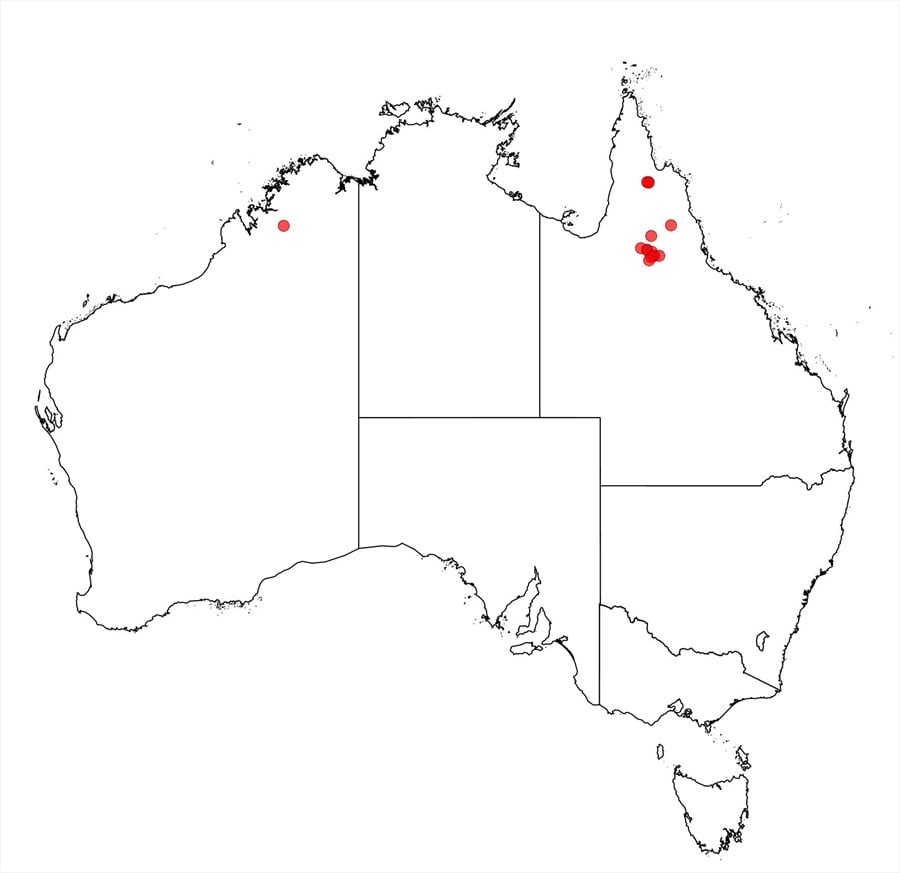Vachellia clarksoniana (Pedley) Kodela
WATTLE
Acacias of Australia
Family
Fabaceae
Distribution
Restricted to the south-central part of Cape York Pen., Qld.
Description
Trees to 5 m tall, facultatively deciduous. Bark tessellated, pale brown. Branchlets hirsute with erect hyaline hairs c. 0.1 mm long and scattered longer ones 0.7 mm, red-glandular trichomes conspicuous on developing leaves. Stipules on flowering stems straight, rather brittle, subspiny, 1.5–2 mm long, often wanting. Leaves: axis 60–80 mm long (including petiole c. 10 mm), indumentum similar to branchlets; gland sessile, 1–1.5 mm long, 0.3–0.5 mm wide, situated immediately below lowest pair of pinnae; pinnae 12–16 pairs, 10–20 mm long; pinnules 15–26 pairs, oblong, 1.8–2.5 mm long, 0.5–0.7 mm wide, midrib prominent on lower surface, long hairs on margin. Heads globular, 13–20 (–30)-flowered; peduncles 15–45 mm long, indumentum similar to branchlets, involucel at about the middle. Flowers 5-merous; calyx gamosepalous; corolla 2.7–3 mm long; anthers with a globular appendage c. 0.1 mm diam. Pods narrowly oblong, straight edged or constricted between seeds, ±flat, 6–12 cm long, 12–17 mm wide, coriaceous to thinly crustaceous, longitudinally reticulate, glabrous or puberulous. Seed longitudinal, elliptic, flat, 9–12 x 7–8, scarcely arillate.
Habitat
Grows in low hilly country in rather open vegetation.
Specimens
Qld: c. 20 mi [32.2 km] N of 'Gamboola', L.Pedley 1849 (BRI, NSW).
Notes
Based on molecular and other data Acacia sens. lat. is now considered as comprising a number of segregate genera, see J.T.Miller & D.S.Seigler, Austral. Syst. Bot. 25: 217-224 (2012) for overview. Many taxa in the former Acacia subg. Acacia are now referable to the genus Vachellia, including the one presented here. Vachellia clarksoniana was referred to by P.G.Kodela, Fl. Australia 11A: 202 (2001) as an undescribed species under Acacia bidwillii.
Has affinities with V. valida which has a larger petiolar gland and a smaller gland between the uppermost 1–3 pairs of pinnae, normally longer pinnae with more, normally larger, pinnules. More distantly related to V. douglasica.
FOA Reference
Data derived from Flora of Australia Volumes 11A (2001), 11B (2001) and 12 (1998), products of ABRS, ©Commonwealth of Australia
Author
B.R. Maslin & P.G. Kodela
This identification key and fact sheets are available as a mobile application:
URL: https://apps.lucidcentral.org/wattle/
© Copyright 2018. All rights reserved.







